Hi guys,
I’m quite desperate right now so let me skip to the point (at the bottom you’ll find tl;dr)
Setup and performance until now
This is my new setup
What is the problem now? Veg took twice the time it took under HIDs, but OK, these LEDs are 3000K so I was expecting slower growth. However, the main problem is that even 3 weeks into flowering I don’t see any real budding. With HIDs it usually took just a couple of days for first pistils to appear, now 3 weeks into flowering only few can be seen... Otherwise, plants are looking very healthy, no visible problems etc.
Otherwise, plants are looking very healthy, no visible problems etc.
I attached few pics for better understanding.
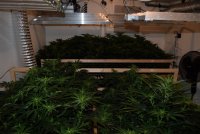
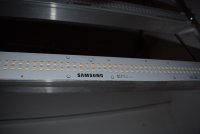
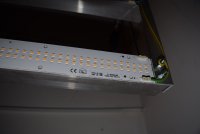
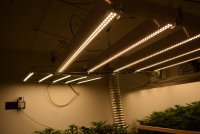
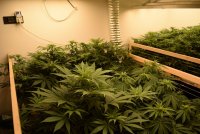
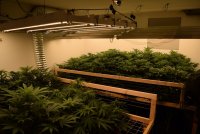
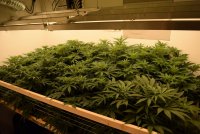
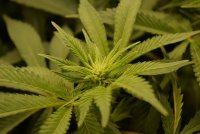
Can someone please explain what am I missing, doing wrong, should be doing differently and most importantly should I keep my optimism or expect failure?
tl;rd: Switched from HID to LEDs, rate of growth and flowering are very slow and in general just underperforming.
I’m quite desperate right now so let me skip to the point (at the bottom you’ll find tl;dr)
Setup and performance until now
- Seasoned indoor grower (~ 6 years)
- Setup: 8x4 (240x120 cm) grow tent
- Lighting: 2x 600w HID (Lumatek, Adjust-a-Wings reflectors)
- Method: SCROG
- Strain: Dinafems’ Moby Dick (8 plants)
- Medium: Soil (Plagron) in classic ~10 gal (40L) pots
- Feeding/nutrients: Canna Terra (Vega, Flores, Rhizotonic, Cannazym, PK13/14)
- Grow cycle: From clones to 75% filled screen 18h MH cycle for about 3 weeks and 2 months of 12h flowering.
- Performance: 1 – 1,25 g/W
This is my new setup
- Setup: 8x4 (240x120 cm) and 6,6x4 (200x120 cm) screen (w/o growbox)
- Lighting: 2 x MeanWell HLG-480H-48A each driving 8 x Samsung HinFlux L09 SL-B8V4N90LAWW 3000K Lm301b diode LED strips + 2 x MeanWell HLG-320H-48A each driving 5 x same LED strips. Strips are mounted on ALU profiles (heatsinks) warming up to 58 – 60 C.
- Method: SCROG
- Strain: Dinafems’ Moby Dick (8 + 4 plants). 4 plants are under additional 6,6x4 (200x120 cm) screen.
- Medium: Soil (Plagron) in ~13,2 gal (50L) AIR pots.
- Feeding/nutrients: Canna Terra (Vega, Flores, Rhizotonic, Cannazym, PK13/14)
- Grow cycle: From clones to 75% filled screen 18h MH cycle for about 1,5 month and almost 3 weeks into flowering I got first signs of buds.
- Performance: /
What is the problem now? Veg took twice the time it took under HIDs, but OK, these LEDs are 3000K so I was expecting slower growth. However, the main problem is that even 3 weeks into flowering I don’t see any real budding. With HIDs it usually took just a couple of days for first pistils to appear, now 3 weeks into flowering only few can be seen...
 Otherwise, plants are looking very healthy, no visible problems etc.
Otherwise, plants are looking very healthy, no visible problems etc.I attached few pics for better understanding.








Can someone please explain what am I missing, doing wrong, should be doing differently and most importantly should I keep my optimism or expect failure?
tl;rd: Switched from HID to LEDs, rate of growth and flowering are very slow and in general just underperforming.





 . "Wattage sweet-spots," if we're being honest, aren't that different, regardless of the technology (IMHO). Heat production... I'd expect it to be somewhere around 3.412141633 (err.. approximately
. "Wattage sweet-spots," if we're being honest, aren't that different, regardless of the technology (IMHO). Heat production... I'd expect it to be somewhere around 3.412141633 (err.. approximately  ) BTU per watt used, again regardless of the technology. With a good air-cooled HID setup, fan to pull air (from somewhere other than the grow space) through the HID reflector(s), attention to possible leaks in the ducting and the fixtures, and a separate ventilation setup to pull air through the grow space, itself, and (if applicable) through a carbon filter... Insulated covers on the (those) HID reflector(s), if available... Ballast(s) moved out of the grow space...
) BTU per watt used, again regardless of the technology. With a good air-cooled HID setup, fan to pull air (from somewhere other than the grow space) through the HID reflector(s), attention to possible leaks in the ducting and the fixtures, and a separate ventilation setup to pull air through the grow space, itself, and (if applicable) through a carbon filter... Insulated covers on the (those) HID reflector(s), if available... Ballast(s) moved out of the grow space... The PPE performs very nice as 2.35~2.45umol/j just as the expensive units over thousand USD in the market.
The PPE performs very nice as 2.35~2.45umol/j just as the expensive units over thousand USD in the market.